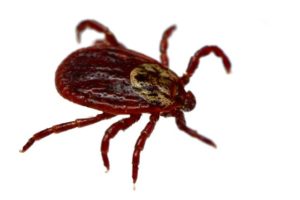by Staff Sgt. Jonathan Bass
86th Airflift Wing Public Affairs
The wilderness of forests in Germany and other European countries call adventurous service members and their families to explore the great outdoors.
Unfortunately, some small but dangerous villains threaten to put a damper on those adventures.
The villains are named Ixodes Ricinus and Dermacentor Reticulatus. They are more commonly known as ticks. 
Ixodes Ricinus, the Castor Bean tick, and Dermacentor Reticulatus, the Ornate Cow tick, are both in the same family as deer ticks, which are commonly found in the United States.
While ticks do attempt to threaten the glorious summer weather, they can be defeated through proper prior planning.
“Ticks prefer the edges of areas, so where there is a change from grass to path or meadow to road, that is where you will find more ticks,” said U.S. Air Force Tech. Sgt. Amber Dorsey, 786th Civil Engineer Squadron pest management craftsman. “Simple physical measures like avoiding the edges of paths, staying out of tall grass, wearing long pants tucked into your boots, and using a blanket on the grass can protect you.”
Ticks, like vampires, have an olfactory weakness too. Sadly, it’s not garlic. It’s Diethyltoluamide, more commonly known as DEET. U.S. Army Maj. Amanda Cline, U.S. Army Public Health Command Europe entomological science program chief, recommends using an insect repellent which contains 20 percent DEET to keep ticks off your skin.
If attached, ticks will take the opportunity to suck blood from the host for up to three days.
In addition to taking your blood, they’ll also leave you with a present – their saliva, which can contain bacteria causing Lyme disease.
Lyme disease traditionally presents with a rash at the infection site which appears to be a classic red “bull’s-eye.” Forty-five percent of people infected with Lyme disease never develop the characteristic bull’s-eye rash, Cline said.
Symptoms of Lyme disease are fever, chills, headache, fatigue, muscle and joint aches, and swollen lymph nodes.
Ticks infected with Lyme disease must attach themselves to a host and additionally feed for at least 24 hours, Cline said.
“Ticks will hang out on tall grass swaying in the breeze, holding on with their back legs while waving their front legs, which are equipped with carbon dioxide-sensing organs, until they sense a warm breathing animal come by,” Dorsey said. “Then they grab onto you and crawl upwards until they find a spot they feel is protected: underarms, waistbands, and the tops of socks are common places. Then they bite down and will stay latched onto you for a couple days before dropping off to breed. So if you immediately check yourself and pets after a walk you should be able to remove ticks before you are even bitten.”
If you find one of these draconian arachnids attached to you, Cline said to ignore all the old wives tales regarding tick removal. Instead, she instructs to use a sterile pair of tweezers and grip the tick as close to the skin as possible. Then, with a gentle but strong motion, pull upwards and away from the skin to remove the tick. Occasionally the jaws of the tick may remain in the skin. In that case, simply set the dead tick aside and use the tweezers to remove the jaws.
After removal, apply anti-bacterial ointment or rubbing alcohol to the affected area. Then place the tick in a sealed container and bring it to the nearest medical treatment facility or veterinary clinic for testing.
For more information about ticks and tick prevention, visit the Center for Disease’s website at www.cdc.gov/ticks.


